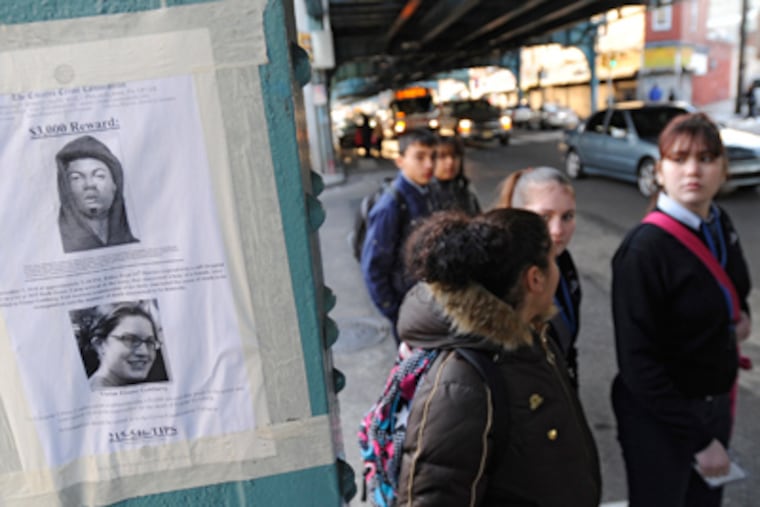An upside of the Kensington dragnet

The increased police scrutiny on Kensington in the wake of a series of murders and sexual assaults has had at least one positive side effect: Women involved with prostitution are coming forward to report crimes committed against them.
"Now that everyone is looking at this area, I think we're getting a lot of things reported to us that probably wouldn't have been," Philadelphia Capt. James Clark said this week.
As authorities continue to hunt for the man or men responsible for three murders and at least three assaults in the area, police have flooded the crime-plagued neighborhood.
Women who work as prostitutes or engage in other illegal activities are often distrustful of cooperating with police, said Jill Maier, director of counseling services for Women Organized Against Rape, a rape crisis and outreach center. But the officers who are canvassing Kensington have demonstrated that they're working hard to find whoever has been terrorizing women there, she said.
"It's great to see the dedication of some of these officers, and the police are getting more of these women coming in to the stations and filing reports," Maier said. "It's really encouraging."
The New Kensington Community Development Corporation is hosting a community vigil Friday night at 6 p.m. at Jasper and Cumberland Streets as a show of neighborhood solidarity.
Three women have been strangled to death in Kensington since Nov. 3, two of whom were killed by the same man, police believe. Two women have reported being choked into unconsciousness and sexually assaulted, and a third has said she was hit with a brick. All three surviving victims have described essentially the same man as their attacker. Police are investigating possible connections between those and several other recent assaults in the area.
The department also has formed a task force of detectives from the Homicide and Special Victims Units, uniformed officers from the 24th and 26th Districts, which cover Kensington, and Vice and Narcotics Field Unit officers. Homicide is leading the force, which also has reached out to federal agencies for any intelligence and assistance they can provide, said Lt. Raymond Evers, police spokesman.
Evers declined to provide the number of officers assigned to the force, but said they were questioning prostitutes, drug dealers and informants. They also are serving arrest warrants and searching for anyone with information on the attacks.
"The area is flooded with law enforcement," he said. "If something happens, the response time is going to be seconds."
In fact, he said, Deputy Commissioner Thomas Wright pulled over a couple of officers who were following a drug dealer in Kensington Thursday. Wright thought the officers, driving an unmarked car, were acting suspiciously.
"We got cops pulling over cops, there are so many out there," Evers said.
The FBI is trying to assemble a profile of the man suspected in two of the murders, who has been linked to the victims by DNA.
Authorities have declined to describe the murders and assaults as the actions of a serial killer or serial rapist. The FBI defines a serial murder case as the "killing of two or more victims by the same offender in separate events," though the agency notes that a 1998 law on sexual predators defined serial killers as having three or more victims.
Brent E. Turvey, who authored the text book "Criminal Profiling: An Introduction to Behavioral Evidence Analysis," said the best results are obtained by putting trained profilers on the actual scene to reconstruct the crime, rather than by off-site analysis.
"You actually have to go and ... figure out what did the offender do? What did the victim do?" said Turvey, who is based in Alaska. "You break down what occurred in the crime ... what decisions were made?"
Generally, offenders who are categorized as serial rapists share certain behavior patterns, according to Barry Zakireh, director of the adult outpatient and forensic programs at the Joseph J. Peters, a local non-profit mental health agency.
Serial rapists are classified as vindictive, meaning that they rape out of anger, as opposed to an opportunistic rape, which might have been committed in the course of another crime. Often in vindictive rape, Zakireh said, violence is the goal, not sex.
The three women who survived attacks in Kensington all said they were approached by a man who offered them money for sex. After they had accompanied him to a deserted location, they told police he attacked them.
"Strangers are easier to target, and particularly women who are prostitutes or are addicted to drugs," Zakireh said. "There's a smaller likelihood for him to be reported, and to be caught. These women are almost the perfect victims, in that sense."
Another pattern of behavior often shared by serial rapists, Zakireh said, is a compulsion to rape that often continues until the offender is arrested.
"Once it gets to a certain level, the likelihood of them stopping is very small," he said. "They may go dormant for a while, they may lay low for one reason or another, but usually something drastic has to happen in order for it to end. Usually people are not able to stop on their own."
Contact staff writer Allison Steele at (215) 854-2641 or asteele@phillynews.com
Staff writer Nathan Gorenstein contributed to this story.
Follow the Inquirer at www.Twitter.com/PhillyInquirer and www.Facebook.com/PhillyInquirer